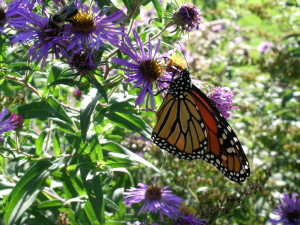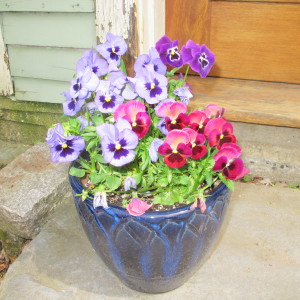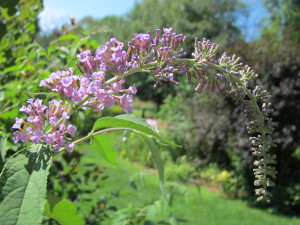Plants for Butterflies, Bees and Native Pollinators
Butterflies are the poster children of the environmental movement. Everybody loves them, and wants to see them thrive. But do you know what you can do to help? It’s quite simple, really. For starters, make sure that your environment includes a wide variety of plants that supply nectar and pollen. And even city dwellers can help.
Let’s say you don’t have a garden, or that you have limited time and/or space. Or you just have a lawn. You can start by planting some annual flowers in a pot, or buying a hanging planter at the garden center. Most planters sold are full of gorgeous flowers that will bloom all summer. All you have to do is water them.
If watering is too much trouble, transfer your purchased plants into a “self-watering” container. These are pots that have a water reservoir in the base that will allow water to wick up to the plants in the container. Get one about the same size as your purchased planter, along with some potting soil. The potting soil should fill in extra space if your self-watering container is larger than the hanging pot. Once you have it set up, you will just need to fill the reservoir once a week.
Another thing that anyone can do is buy a bird bath. Yes, a bird bath can be useful for butterflies, too. They need a regular source of water. Butterflies love the minerals found in water in mud puddles, so you could dig a little hole and keep it full for them. Maybe your dog, if she’s like mine, will wallow in it, too. Hmmm…
I have a bird bath that is never used by birds, even after I put stones in the middle for them to perch on. Why? Someone finally pointed out to me that I have a stream just 50 feet from the bath, which is more inviting for the birds. But I like the looks of the blue ceramic bird bath, which I now call my ”butterfly bath”.
What else can you do? Start by swearing off pesticides. I know it’s easy to spray Japanese beetles or potato beetles, but chemicals that kill one kind of bug will kill others, including butterflies and the caterpillars that become butterflies. So hand pick your pests, or agree to let them live. Many insect pests have a short life span and aren’t really as bad as you might think.
Hiking through France I have often been struck by the number and variety of birds, butterflies and pollinators along the trail. I attribute that to the fact that farmers in France allow hedgerows to separate farm fields. Flowering plants like hawthorns, blackberries and wild cherries are not mowed down, but allowed to grow – and provide space for birds and insects to nest in and thrive.
Here in America President Nixon’s Secretary of Agriculture, Earl Butz, told farmers to “get big or get out”, encouraging them to plant commodity crops every square inch, “fencerow to fencerow”. That policy has affected our birds and butterflies over the years. But on a small scale, we can allow native plants to grow and blossom along our property lines. Leave wild spaces wherever you can.
If you want more butterflies, think first about the caterpillars that will become butterflies. What do they like? Dill and fennel are among the best plants for many species. Hollyhocks, lupine, milkweed and butterfly weed, thistles and willows are all good for caterpillars of various sorts.
Then, for nectar and pollen, think about creating a garden that blooms from early spring to late fall. Annual flowers are great because most will do just that. Alyssum, calendula, cosmos, marigolds, nasturtiums, pansies, verbenas and zinnias are some that are especially good.
Of the perennial flowers, here are some good ones: asters, bee balm, daylilies, delphinium, dianthus, globe thistle, hollyhocks, Joe Pye weed, lavender, liatris (gayfeather), oregano, phlox, purple coneflower, sage, scabiosa, sedums, Shasta daisy and yarrow.
Weeds are good for butterflies, too. You know milkweed is beloved by monarchs. Queen Anne’s lace is loved by many. Towards fall I often see goldenrod just full of bees and butterflies. And not all goldenrod is 5 feet tall and aggressive. You can actually purchase tidy ones like‘Fireworks’ (a variety of Solidago rugosa), or a small shade-loving one, Solidago caesia. Talk to your local nursery – they can get them from North Creek Nursery in Landenberg, Pennsylvania (wholesale only).
The very best plant for butterflies is probably butterfly bush (Buddleia davidii). This is a shrub that is generally hardy only to Zone 5, meaning that temperatures colder than minus 20 will kill it. In warmer zones it can spread aggressively and even be considered an invasive pest. But is great for butterflies, and often will survive in Zone 4, just dying back to the ground each year, but blooming late in the summer. It can be a large shrub, but there are smaller varieties, too.
Remember: butterflies and bees need nectar or pollen – from spring dandelions to late fall-blooming witchhazel. You can do your part – and enjoy seeing both your flowers and the butterflies, too.
To learn about bumblebees – all of them you see right now are queens – go to Henry’s blog: https://dailyuv.com/news/





